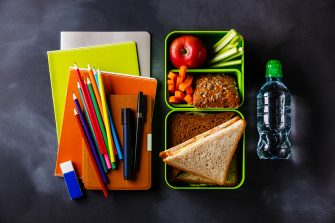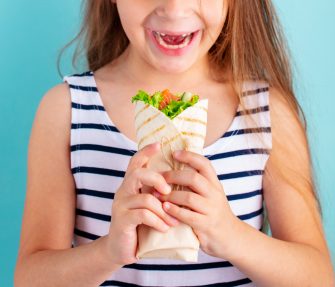Take your Packed Lunch Back to School
 It’s a new school and with it comes bright, new, shiny notebooks, backpacks, pencils and all the fun supplies students need for a great year of learning. When it comes to lunch, a boring sandwich in a plastic bag, some chips and a piece of fruit all dropped into a brown paper bag is dull and boring by comparison. With a few easy changes you can take that blah to a “WOW!” and give your student a lunch to look forward to! Check out these tips to add some pizzazz, and nutrition, to create an A+ lunch.
It’s a new school and with it comes bright, new, shiny notebooks, backpacks, pencils and all the fun supplies students need for a great year of learning. When it comes to lunch, a boring sandwich in a plastic bag, some chips and a piece of fruit all dropped into a brown paper bag is dull and boring by comparison. With a few easy changes you can take that blah to a “WOW!” and give your student a lunch to look forward to! Check out these tips to add some pizzazz, and nutrition, to create an A+ lunch.
 Make it colorful! Including a variety of colors not only makes the meal look more appetizing, when that color comes from fresh fruits and vegetables, it can also be “extra credit” in the nutrition category. Things like carrots, blueberries, strawberries, cherry tomatoes and cucumbers are all fun, nutritious additions to the lunch.
Make it colorful! Including a variety of colors not only makes the meal look more appetizing, when that color comes from fresh fruits and vegetables, it can also be “extra credit” in the nutrition category. Things like carrots, blueberries, strawberries, cherry tomatoes and cucumbers are all fun, nutritious additions to the lunch.
 Shape it up! Why so many kids get so wound up over their sandwich being in triangles or squares or how a food’s shape affects it’s flavor, is a mystery to most adults. But this is 1 area that you can use that battle to your advantage. Use a melon baller to scoop out larger fruits like cantaloupe or watermelon. Cookie cutters can create sandwiches and even some fruit and cheeses into fun shapes that young children love. Don’t want to waste the edges? Use a pastry wheel to add flair to the simple act of cutting a sandwich into 2-4 triangles or rectangles.
Shape it up! Why so many kids get so wound up over their sandwich being in triangles or squares or how a food’s shape affects it’s flavor, is a mystery to most adults. But this is 1 area that you can use that battle to your advantage. Use a melon baller to scoop out larger fruits like cantaloupe or watermelon. Cookie cutters can create sandwiches and even some fruit and cheeses into fun shapes that young children love. Don’t want to waste the edges? Use a pastry wheel to add flair to the simple act of cutting a sandwich into 2-4 triangles or rectangles.
Change it up. Even as adults, we get tired of the same old, same old meals. Find several options your child likes and rotate them. Even if it’s only a few options for the protein, rotate the sides and treats. Tanya Steel, editor-in-chief of Epicurious.com and author of Real Food for Healthy Kids, recommends packing at least three different types of food every day. “Think of the lunchbox as a meal on a plate, with protein, complex crabs, fresh produce and a wholesome treat on the side.”

Presentation, presentation, presentation. There are several lunch boxes that have compartments for separating foods. But if you don’t want to go to that expense, you can use smaller, inexpensive containers or silicone cupcake liners to create colorful, and reusable individual compartments in your child’s lunchbox. Add a layer of fun by making little skewers (toothpicks are great for this!) of foods or creating roll-ups of their favorites.
 Make it convenient. Remember the “KISS” (Keep It Simple Stupid”) method? Lunchtime for most children is brief and a prime time for socializing as well. By packing lunches that are easy to handle, it helps them balance eating and talking a little better. The more time they are fighting their food, the less time they are eating it. Handheld foods generally fare better in this regard. Having that sandwich cut into smaller pieces or those vegetables cut into matchsticks makes it easier for the students to eat quickly. If you pack a salad or other food that requires utensils, be sure to pack them with the lunch!
Make it convenient. Remember the “KISS” (Keep It Simple Stupid”) method? Lunchtime for most children is brief and a prime time for socializing as well. By packing lunches that are easy to handle, it helps them balance eating and talking a little better. The more time they are fighting their food, the less time they are eating it. Handheld foods generally fare better in this regard. Having that sandwich cut into smaller pieces or those vegetables cut into matchsticks makes it easier for the students to eat quickly. If you pack a salad or other food that requires utensils, be sure to pack them with the lunch!
Encore! Encore! Wikipedia defines an encore as “an additional performance … after the planned show has ended, usually in response to extended applause from the audience… they initially originated spontaneously, when audiences continued to applaud and demand additional performance from the artist.” An encore doesn’t have to be relegated to only musical performers. Having leftovers sounds dull and boring. But when you bring out “Encores” that’s something different entirely. Leftover meat can become a wrap or sandwich for the next day’s lunch. Catherine McCord, founder of Weelicious, a website filled with recipes, suggests: “Repurpose everything…If you have chicken fajitas Monday night, then it’s chicken quesadillas for Tuesday’s lunch. I would dare say almost anything you make for dinner can be put in a quesadilla the next day.” She points out this can work for breakfasts as well. Create pancake sandwiches with breakfast leftovers, layering the pancakes (or waffles) with cream cheese and preserves.
 Get your child involved. From choosing foods at the grocery store, preparing meals at home and even packing lunch for school, bring your child into the conversations as is age appropriate. For younger children, give them a few options to choose from (i.e. Do you want grapes or blueberries?). Then, as they grow and mature, allow them a larger part in the decision-making process. Even young children can help in the kitchen. You measure, but they pour it into the mix while you stir. You cut up carrot sticks and they count out the appropriate number to put in bags for the week. As you do this, you not only are building up their food knowledge, but also strengthening your relationship with them and reinforcing gross motor skills and even math skills! Plus, when they help pick out and prepare the food, they may be more likely to actually eat it!
Get your child involved. From choosing foods at the grocery store, preparing meals at home and even packing lunch for school, bring your child into the conversations as is age appropriate. For younger children, give them a few options to choose from (i.e. Do you want grapes or blueberries?). Then, as they grow and mature, allow them a larger part in the decision-making process. Even young children can help in the kitchen. You measure, but they pour it into the mix while you stir. You cut up carrot sticks and they count out the appropriate number to put in bags for the week. As you do this, you not only are building up their food knowledge, but also strengthening your relationship with them and reinforcing gross motor skills and even math skills! Plus, when they help pick out and prepare the food, they may be more likely to actually eat it!
Recreate the “it” lunch. Whether it’s a certain brand of prepared lunch snacks or they are just in a phase of only liking a handful of foods, kids can go through phases when getting proper nutrition in them can be difficult. Look at what that favorite food is and see how you can recreate it. Your child wants a popular packaged lunch kit that is nothing more than cracker, sandwich meat, cheese and a cookie? Make your own with your baked chicken encore from last night’s dinner, whole grain crackers or pita, cheese and fresh fruit or a homemade cookie. Have a child in the “I only want a PBJ sandwich” phase? Substitute a portion of the ingredients for healthier options. Make the sandwich with 1 piece while bread and 1 piece wheat bread. Mix high-sugar jelly with an all fruit spread to get a healthier jelly. Use all-natural nut butter, or mix natural with regular processed peanut butter. Start with a 50/50 mix and over time, you can move to 60/40, to 70/30, etc. until they are eating the lower processed, lower sugar options without even realizing it.
Packed lunch doesn’t have to be a sandwich meat. With so many options available, don’t limit yourself to a sandwich with highly processed meat as the daily lunch. Explore variations with nut butters, fruit spreads, hummus, various cheeses and salads. Check out this listing from Kids Eat in Color to get your creative juices flowing to change up that boring sandwich.

If your child is bringing home their meal uneaten, Harvard Health suggests asking the child why they didn’t eat it. In their article on School Lunches, they note that some of the most common reasons lunches weren’t eaten are issues that can easily be solved.
 Did the child not like the food? Maybe it’s time to include them more in the decision-making process. Or it might be time to add another layer of variety.
Did the child not like the food? Maybe it’s time to include them more in the decision-making process. Or it might be time to add another layer of variety.- Was the food too messy or hard to eat? Look at how the food is prepared and packaged. Maybe the apple needs to be cut up in advance (then put a clean rubber band around it to hold it together so it won’t turn brown before time to be eaten). Perhaps the food needs to be cut into smaller or larger pieces.
- Is the container too hard for the child to open on their own? Try a different container or do not close it as tight.
- Was the food not at the correct temperature? The addition of ice packs (or frozen wet sponges in a water tight bag or freezing a beverage) can help keep things cool. Conversely, putting hot water in a thermos to heat it up, then dumping it out and putting food that has been heated hotter than normal in it can help hot foods stay warm until lunch.
 The internet is home to a host of blogs and articles on ways to amp up the nutrition in your child’s school lunch as well as a plethora of tips on ways to make it easier for you. Check them out from time to time. However, be aware that while they may have ideas that look and sound good, that doesn’t always mean it is accurate as far as nutrition goes. Some are registered dieticians, nutritionists or have done extensive research. But that’s not the case for all. So check the sources and credentials in order to make informed decisions that are best for your family’s health.
The internet is home to a host of blogs and articles on ways to amp up the nutrition in your child’s school lunch as well as a plethora of tips on ways to make it easier for you. Check them out from time to time. However, be aware that while they may have ideas that look and sound good, that doesn’t always mean it is accurate as far as nutrition goes. Some are registered dieticians, nutritionists or have done extensive research. But that’s not the case for all. So check the sources and credentials in order to make informed decisions that are best for your family’s health.
Have questions about nutrition? Your chiropractic physician has been trained to provide information and advice on health and wellness related topics including nutrition and dietary tips. When needed, they can also help you find and work with other health care specialties to reach your health goals. If you don’t already have a local chiropractor, you can find a TCA member doctor of chiropractic near you here.
SOURCES:
Major, Mandy. Woman’s Day. August 28, 2012. http://www.womansday.com/food-recipes/cooking-tips/tips/a5862/how-to-pack-a-better-school-lunch-120119/ accessed 8.7.2023
Harvard Health. “School Lunches”. July 16, 2016 https://www.health.harvard.edu/child-and-teen-health/school-lunches accessed 8.7.2023
Kids Eat in Color. “Best Sandwiches for Kids Beyond the Deli Meat” June 2019 – Last reviewed: September 2022 https://kidseatincolor.com/sandwiches-beyond-the-deli-meat/ accessed 8.6.2023
Wikipedia. “Encore” https://en.wikipedia.org/wiki/Encore